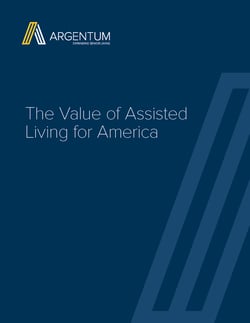Argentum released an updated edition of The Value of Assisted Living in America. The industry-leading report makes clear the critical role that assisted living plays in caring our nation’s seniors, in offering significantly lower costs, improved quality of life, better health outcomes, and reduced health care costs for public programs like Medicare, Medicaid, and veterans’ care.
The report includes a host of findings and offers several policy solutions, including:
- Improve access to assisted living for veterans. Current Veteran benefit programs created to assist veteran populations are under-utilized and in need of reform. If the Aid and Attendance benefit is effectively utilized, veterans could receive the care they need in the setting of their choice instead of having no choice but to go into the Medicaid program.
- Increase access and affordability and expand workforce training programs. Federal legislation would establish a cost-reduction program for lower-income seniors and workforce training programs to offer specializations in senior care to meet the needs of older adults.
- Promote socialization and support our caregiver’s family care needs. The Social Engagement and Network Initiatives for Older Relief (SENIOR) Act and the Care Across Generations Act would help seniors stay more connected and offer caregivers with children of childcare age on-site placement, as many workers report difficulties with finding reliable childcare.
- Promote tax reforms to invest in workforce development. The Improve and Enhance the Work Opportunity Tax Credit Act would help more long-term care communities hire caregivers.
- Support Foreign-born Workforce Programs. Increasing immigrant flows into the US may be one actionable policy solution to ensure there is an adequate workforce to ensure the rapidly aging population has access to quality long-term care.
- Strengthen Long-Term Care Insurance. Several measures have been proposed to improve the viability of private long-term care insurance.
- Increase Public Program Reimbursements. Inadequate reimbursements have limited the ability for assisted living communities to participate.
Among the reports findings include:







